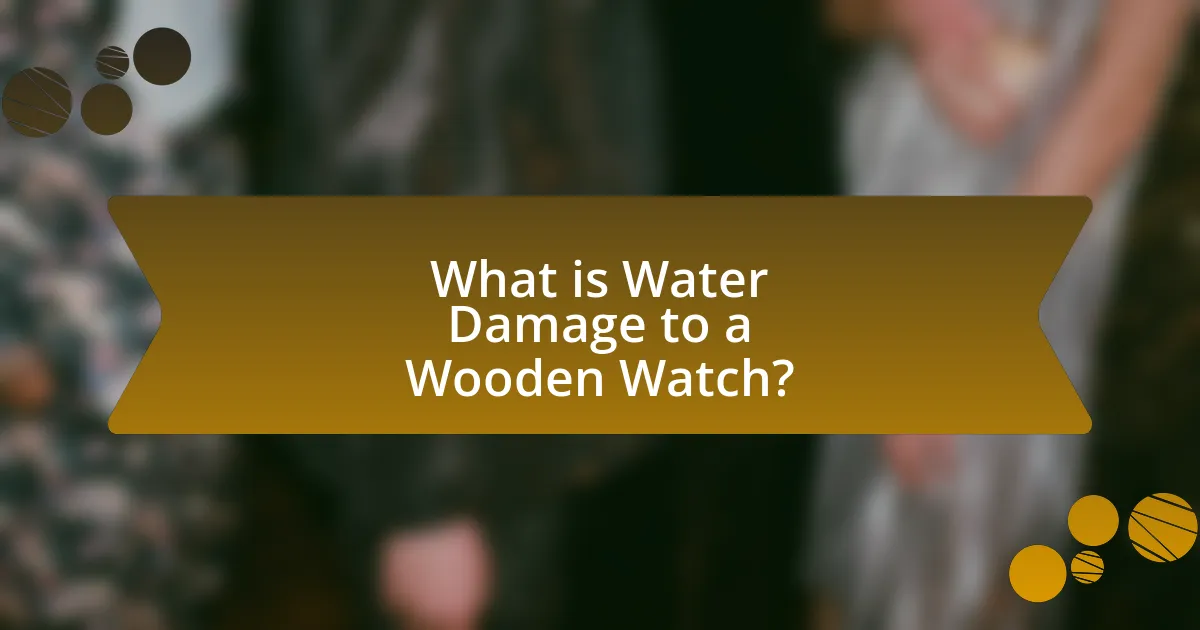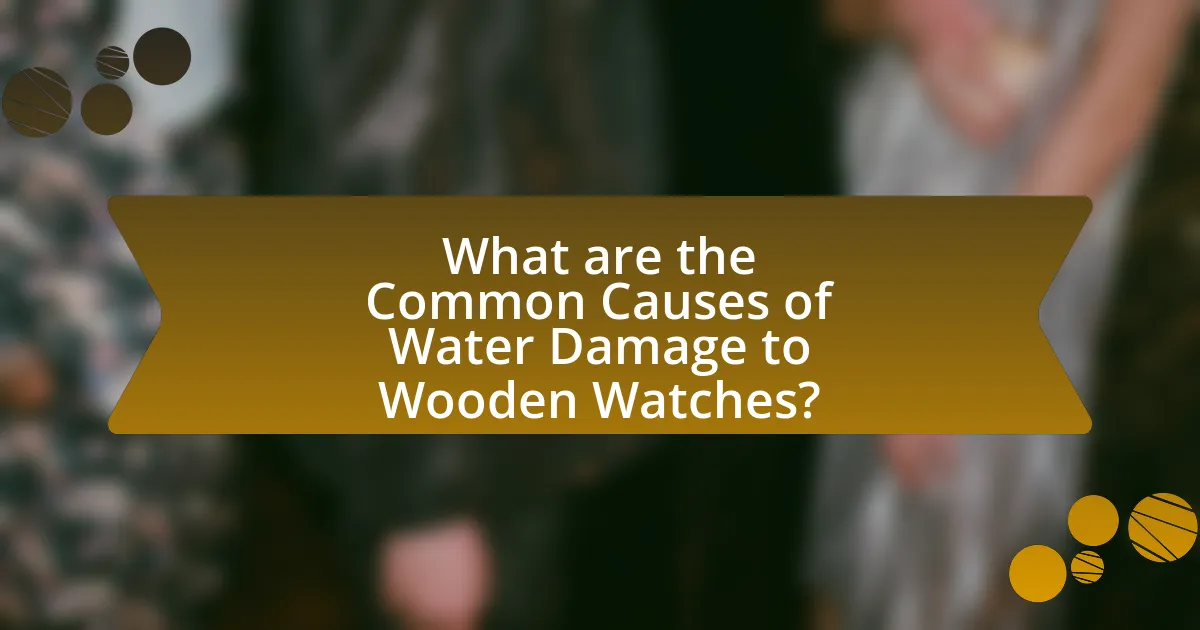Water damage to wooden watches occurs when moisture infiltrates the wood, leading to warping, swelling, and cracking, which compromises both structural integrity and aesthetic appeal. This article outlines the effects of water damage on wooden watches, including how moisture impacts the materials and functionality, and identifies specific types of wood that are particularly vulnerable. It also discusses common causes of water exposure, preventive measures to protect wooden watches, and best practices for maintenance and storage. Emphasizing the importance of keeping wooden watches dry, the article provides practical tips for safeguarding these delicate timepieces from water-related damage.

What is Water Damage to a Wooden Watch?
Water damage to a wooden watch occurs when moisture penetrates the wood, leading to warping, swelling, or cracking. This damage compromises the structural integrity and aesthetic appeal of the watch, as wood is a porous material that absorbs water. Prolonged exposure to water can also affect the watch’s internal mechanisms, potentially causing rust or malfunction.
How does water damage affect the materials of a wooden watch?
Water damage can cause significant deterioration of the materials in a wooden watch, leading to warping, swelling, and potential cracking of the wood. When exposed to moisture, the wood absorbs water, which disrupts its structural integrity and can result in permanent damage. Additionally, water can compromise the watch’s finish, leading to discoloration and loss of luster. The internal components, such as the movement and battery, may also be affected, potentially causing malfunction or complete failure. Studies indicate that prolonged exposure to water can reduce the lifespan of wooden items, emphasizing the importance of keeping wooden watches dry to maintain their functionality and appearance.
What specific types of wood are most vulnerable to water damage?
Softwoods such as pine, cedar, and fir are most vulnerable to water damage. These types of wood have a lower density and higher porosity, which allows water to penetrate more easily compared to hardwoods. For instance, studies show that softwoods can absorb moisture at a rate significantly higher than hardwoods, leading to warping, swelling, and decay when exposed to water over time.
How does moisture impact the watch’s finish and appearance?
Moisture negatively impacts a watch’s finish and appearance by causing damage to the materials and leading to deterioration. Specifically, exposure to moisture can result in water spots, tarnishing of metal components, and degradation of wooden elements, which may warp or swell. For instance, wooden watches are particularly susceptible to moisture, as prolonged exposure can compromise their structural integrity and aesthetic appeal, leading to discoloration and loss of luster.
Why is it important to prevent water damage to wooden watches?
Preventing water damage to wooden watches is crucial because moisture can cause the wood to swell, warp, or crack, compromising the watch’s structural integrity and aesthetic appeal. Wooden watches are typically made from natural materials that are sensitive to environmental changes; exposure to water can lead to irreversible damage. For instance, a study by the Wood Research Institute indicates that prolonged exposure to water can reduce the lifespan of wooden products significantly, emphasizing the need for protective measures against moisture.
What are the long-term effects of neglecting water damage prevention?
Neglecting water damage prevention can lead to severe long-term effects, including structural deterioration, mold growth, and irreversible damage to wooden materials. Over time, untreated water exposure can cause wood to warp, crack, or rot, compromising the integrity of the watch. Additionally, mold can develop in damp environments, posing health risks and further damaging the wood. According to the Environmental Protection Agency, mold can begin to grow within 24 to 48 hours of water exposure, emphasizing the urgency of prevention. Ultimately, the cumulative effects of neglecting water damage prevention can result in costly repairs and a significantly reduced lifespan of the wooden watch.
How can water damage affect the functionality of a wooden watch?
Water damage can severely impair the functionality of a wooden watch by causing the wood to swell, warp, or crack. When exposed to moisture, the natural fibers in the wood absorb water, leading to dimensional changes that can disrupt the watch’s internal mechanisms. This can result in inaccurate timekeeping, difficulty in movement, or complete failure of the watch to operate. Additionally, prolonged exposure to water can promote mold growth and deterioration of the wood, further compromising the watch’s integrity and functionality.

What are the Common Causes of Water Damage to Wooden Watches?
Common causes of water damage to wooden watches include exposure to moisture, high humidity, and submersion in water. Moisture can penetrate the wood, leading to warping, swelling, or cracking. High humidity levels can cause the wood to absorb excess moisture, compromising its structural integrity. Submersion in water, even for a short period, can result in significant damage, as wooden materials are not inherently waterproof. These factors highlight the importance of keeping wooden watches away from water sources to maintain their longevity and functionality.
How can everyday activities lead to water exposure?
Everyday activities can lead to water exposure through routine actions such as washing hands, showering, or engaging in outdoor activities during rain. These actions often involve direct contact with water, which can inadvertently affect items like wooden watches. For instance, studies indicate that prolonged exposure to moisture can cause wood to swell, warp, or crack, compromising the integrity of wooden materials. Additionally, activities like swimming or washing dishes can result in splashes or spills that further increase the risk of water damage to wooden watches.
What types of environments pose the greatest risk to wooden watches?
Environments with high humidity, extreme temperatures, and exposure to water pose the greatest risk to wooden watches. High humidity can cause wood to swell and warp, while extreme temperatures can lead to cracking or splitting. Additionally, direct exposure to water can damage the wood and the watch’s internal mechanisms, leading to malfunction. For instance, a study by the Wood Research Institute indicates that wood absorbs moisture, which can compromise its structural integrity, making it essential to keep wooden watches away from such conditions.
How does humidity contribute to water damage?
Humidity contributes to water damage by increasing moisture levels in the air, which can lead to the absorption of water by materials, particularly wood. When wood absorbs excess moisture due to high humidity, it can swell, warp, or crack, compromising the structural integrity of wooden items like watches. Studies indicate that wood can absorb moisture at relative humidity levels above 60%, significantly increasing the risk of damage. Therefore, maintaining a controlled humidity level is essential to prevent such adverse effects on wooden objects.
What accidental situations can cause water damage?
Accidental situations that can cause water damage include overflowing sinks, burst pipes, and accidental spills. Overflowing sinks can occur due to clogged drains, leading to water pooling and damaging surrounding areas. Burst pipes, often caused by freezing temperatures or corrosion, can release large volumes of water rapidly, resulting in significant damage. Accidental spills, such as knocking over a drink, can also lead to localized water damage if not promptly cleaned up. These situations highlight the importance of vigilance in preventing water exposure to sensitive items like wooden watches.
How can spills or splashes affect a wooden watch?
Spills or splashes can cause significant damage to a wooden watch by compromising its structural integrity and finish. When water comes into contact with wood, it can lead to swelling, warping, or cracking, as wood is a porous material that absorbs moisture. Additionally, prolonged exposure to water can damage the watch’s protective coatings, leading to discoloration and deterioration of the wood. This is supported by the fact that wood is hygroscopic, meaning it naturally absorbs moisture from its environment, which can alter its shape and appearance over time.
What role does improper storage play in water damage risk?
Improper storage significantly increases the risk of water damage to wooden watches. When wooden watches are stored in humid or damp environments, the moisture can penetrate the wood, leading to warping, cracking, or mold growth. According to the National Wood Flooring Association, wood absorbs moisture from the air, and high humidity levels can cause dimensional changes in wood products. Therefore, storing wooden watches in dry, climate-controlled conditions is essential to mitigate the risk of water damage.

What Preventive Measures Can Be Taken to Protect Wooden Watches?
To protect wooden watches, owners should apply a waterproofing sealant specifically designed for wood, which creates a barrier against moisture. Regularly applying this sealant helps maintain the wood’s integrity and prevents water damage. Additionally, storing wooden watches in a dry environment and avoiding exposure to extreme humidity or direct water contact further safeguards them. Research indicates that wood can absorb moisture, leading to warping or damage, thus reinforcing the importance of these preventive measures.
How can you effectively waterproof a wooden watch?
To effectively waterproof a wooden watch, apply a high-quality wood sealant or waterproofing oil specifically designed for wood. These products penetrate the wood fibers, creating a barrier against moisture while preserving the watch’s natural appearance. For instance, products containing tung oil or linseed oil are known for their water-resistant properties and can enhance the durability of the wood. Regular application, typically every six months, ensures continued protection against water damage, as untreated wood can absorb moisture, leading to warping or deterioration.
What products are recommended for waterproofing wooden watches?
To waterproof wooden watches, products such as natural oils, waxes, and specialized wood sealants are recommended. Natural oils like tung oil and linseed oil penetrate the wood, providing a moisture barrier while enhancing the grain. Waxes, such as beeswax or carnauba wax, can be applied as a top coat to create a water-resistant layer. Additionally, specialized wood sealants designed for outdoor use can offer robust protection against water damage. These products are effective because they form a protective layer that prevents moisture from penetrating the wood, thus preserving the integrity and appearance of the watch.
How often should waterproofing treatments be applied?
Waterproofing treatments should be applied every 6 to 12 months to effectively protect wooden watches from water damage. Regular application ensures that the protective barrier remains intact, as factors like exposure to moisture and environmental conditions can degrade the treatment over time. Consistent maintenance is crucial for preserving the integrity and longevity of the wooden material.
What daily care practices can help prevent water damage?
Daily care practices that can help prevent water damage to a wooden watch include regularly applying a protective wax or oil, ensuring the watch is kept in a dry environment, and avoiding exposure to moisture. Applying a specialized wood conditioner creates a barrier against water, while storing the watch in a climate-controlled area minimizes humidity. Additionally, removing the watch before activities that involve water, such as swimming or showering, significantly reduces the risk of water exposure. These practices are essential because wood is porous and can absorb moisture, leading to warping or damage over time.
How should you clean and maintain a wooden watch to avoid moisture issues?
To clean and maintain a wooden watch and avoid moisture issues, regularly wipe it with a soft, dry cloth to remove dirt and moisture. This practice prevents water from penetrating the wood, which can cause warping or damage. Additionally, applying a specialized wood conditioner every few months helps to seal the wood and protect it from moisture. Research indicates that untreated wood can absorb up to 30% of its weight in water, leading to significant deterioration over time. Therefore, consistent maintenance and proper cleaning techniques are essential for preserving the integrity of a wooden watch.
What storage solutions can minimize water exposure?
To minimize water exposure for a wooden watch, use airtight containers or waterproof cases specifically designed for watches. Airtight containers prevent moisture ingress, while waterproof cases provide an additional layer of protection against water damage. Research indicates that maintaining a humidity level below 50% can significantly reduce the risk of water-related issues in wooden items, including watches. Therefore, utilizing these storage solutions effectively safeguards the watch from potential water damage.
What are the best practices for handling a wooden watch in wet conditions?
To handle a wooden watch in wet conditions, it is essential to keep it as dry as possible. Avoid exposing the watch to rain, humidity, or water splashes, as wood can absorb moisture, leading to warping or damage. If the watch does get wet, promptly wipe it down with a soft, dry cloth to remove any moisture. Additionally, consider applying a protective finish or sealant specifically designed for wood to enhance its water resistance. This practice is supported by the fact that untreated wood is porous and can swell when exposed to water, which compromises its structural integrity.
How can you protect your watch during outdoor activities?
To protect your watch during outdoor activities, use a protective case or pouch specifically designed for watches. This case will shield the watch from impacts, moisture, and dirt, which are common hazards during outdoor activities. Additionally, ensure that the watch is water-resistant; many wooden watches come with a water-resistant rating, which helps prevent water damage. For instance, a watch rated at least 30 meters can withstand splashes and brief immersion in water. Regularly check the seals and gaskets of the watch to maintain its water resistance, as wear and tear can compromise these features.
What precautions should be taken when washing hands or swimming?
When washing hands, use soap and water for at least 20 seconds to effectively remove germs. This practice is supported by the Centers for Disease Control and Prevention, which emphasizes that thorough handwashing significantly reduces the risk of illness. When swimming, avoid submerging wooden watches in water, as prolonged exposure can lead to damage. The American Academy of Pediatrics advises keeping wooden items away from water to maintain their integrity.
